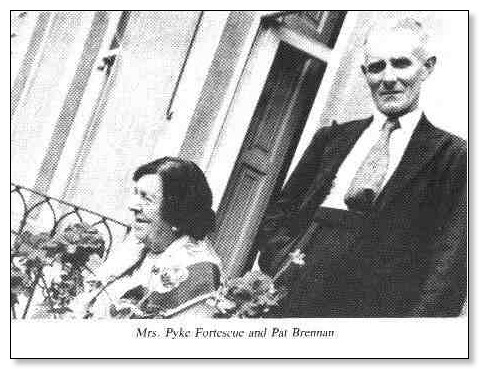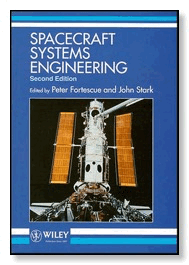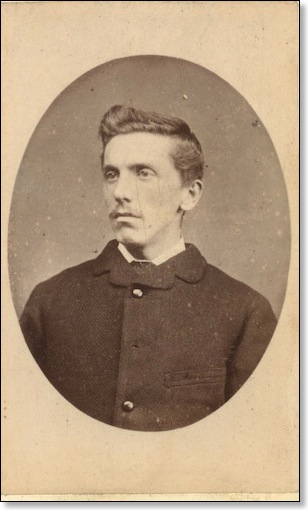P. Fortesque (Sciences)
Magnetic stimulation of human peripheral nerve and brain:
response enhancement by combined magnetoelectrical technique.
Neurosurgery 1987 Jan;20(1):110-6 (ISSN: 0148-396X)
Bickford RG; Guidi M; Fortesque P; Swenson M
The authors describe the technique of magnetic stimulation from a pulsed induction coil (4.0 T) and the enhanced (5-fold) electromyogram response from hyperthenar muscles obtained when electric and magnetic stimuli are applied simultaneously. The enhancement results have been confirmed for central brain vertex stimulation using the Sheffield magnet. Results obtained with slow (1 to 6 seconds) depth electrode stimulation and recording in humans are compared and are used to predict probable developments in the magnetic field. Because magnetic and magnetoelectrical techniques are painless, noninvasive, and noninjurious, it is believed that they are an important advance in both research and clinical applications of instrumental modification of brain circuits and behavior. There are many diagnostic and therapeutic uses at peripheral and central levels, and some ethical problems need consideration.
Indexing Check Tags: Human
anguage: English
MEDLINE Indexing Date: 198705
Publication Type: JOURNAL ARTICLE
Magnetic stimulation of human peripheral nerve and brain: response enhancement by combined magnetoelectrical technique.
Bickford RG; Guidi M; Fortesque P; Swenson M
Peter W. Fortescue (Sciences)
Books on Astronautics,
Spacecraft Design and Spacecraft Systems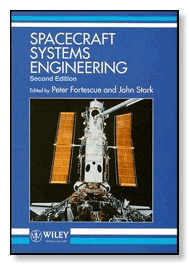
• P. Fortesque and J. Stark, Spacecraft Systems Engineering, John Wiley and Sons, 1995.
| Spacecraft Systems Engineering, 2nd Edition | by Peter W. Fortescue (Editor), John P. W. Stark (Editor)
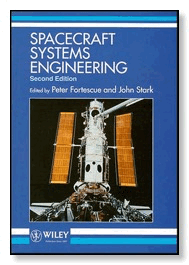
Paperback - 600 pages 2 edition (August 30, 1995)
John Wiley & Sons; ISBN: 0471952206 ; Dimensions (in inches): 1.47 x 9.58 x 6.60
![]()
Book Description
The material in this book is essential for engineers studying and working in the field of spececraft design. The unique feature of this book is that its coverage aims at giving the breadth which is needed by system engineers, with an emphasis on the bus aspect rather than on the payload. This second edition is an updated of the first, and includes two estra chapters. The first is on Mechanisms, and the second is on the subhject of Systems Engineering, and it includes examples of applications to different types of missions.
Raumfahrt und Satellitentechnik |


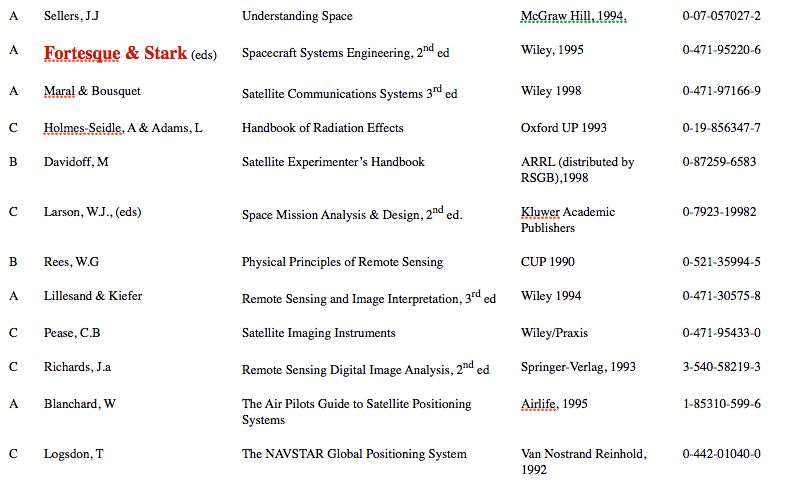
Spacecraft Systems | ||

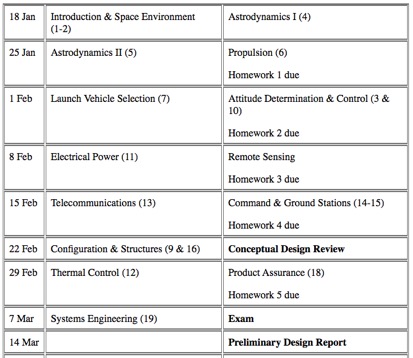
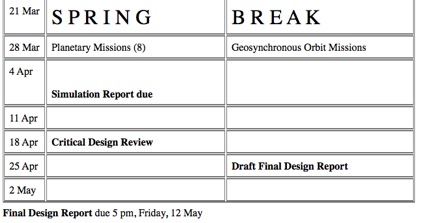

![]()
| | | |||||||||||||||||
| Selected Texts | ||||||||||||||||||
| Moss J. B., "Launch Vehicles", Spacecraft Systems Engineering, 2nd Edition, ed. | P. Fortescue and J. Stark, pp 145, John Wiley, 1995, ISBN 0-471-952206.
| The Space review, Airclaims, June 1992. |
| "Long March Crash to End Insurance Discounts", Interspace, European Satellite and Space News Ltd, pp 1 & 4, 21 February 1996. |
| Wilson A., "Launchers", Jane’s Space Directory, 11th Edition, Jane’s Information Group Ltd, 1995, ISBN 0-7106-12591. |
| Fortescue P. | and Stark J., Failures, Spacecraft Systems Engineering, 1st Edition, pp 396-397, John Wiley, 1991, ISBN 0-471-927945.
| Fortescue P. | and Stark J., Spacecraft Systems Engineering, 1st Edition, pp 6, John Wiley, 1991, ISBN 0-471-927945.
| The Discovery Project Statement of Objectives, NASA policy statement, NASA, http://www.nasa.gov, 1992. |
ERR050 Rymdteknik
(2,5 poäng)
(Space Techniques)
0741 - Radio- och rymdvetenskap
Examinator: Susanne Aalto Bergman
Rymdteknik är ett område med snabbt växande betydelse för Sverige liksom internationellt. Det är därför viktigt att vara medveten om problem och principer för rymdvetenskap och rymdteknik.
KURSENS SYFTE
Avsikten med kursen är att introducera några av de grundläggande aspekterna på rymdteknik, från en elektroteknisk synvinkel. Kursen är delvis översiktlig samtidigt som vissa problem av grundläggande intresse får en fördjupad analys. Tillämpningar kommer att ges utgående bl. a. från aktuella ESA-projekt. Kursen kan följas av teknologer i 3:e året. För vidare analys hänvisas t ex till ERR060 Satellite links, ERR011 Radar och fjärranalys .
KURSENS INNEHÅLL OCH ORGANISATION
Rymdhistorik, Sveriges roll i rymden. Satellitens omgivning: vakuum, tyngdlöshet, jordens atmosfär och jonosfär, geomagnetism, strålningsbälten, mikrometeorider och rymdskrot, solstrålning och solvind. Satellitbanor: Keplers lagar, banstörningar och korrektion av dem, geostationära banan. Satellitens läge på himlen. Raketer och raketuppskjutning. Satellitkonstruktion: materialval, energikällor, temperaturreglering, attityd- och banreglering, telemetri, telekommando och baninmätning, tillförlitlighetsaspekter, rymdkvalifikation. Satellitkommunikation: antenner, mottagare, bruskällor, länk-beräkningar.
Satellittillämpningar: Fjärranalys, navigering, astronomi, aeronomi, materialvetenskap.
I kursen ingår en obligatorisk inlämningsuppgift som utföres med hjälp av dator.
KURSLITTERATUR
P. Fortescue & J. Stark (red.): Spacecraft Systems Engineering, Wiley, 1995.
EXAMINATION
Skriftlig tentamen.

AAE 490E Course Details
Prerequisites:
ECE 201 and Junior-level standing
Fortesque and Stark, Spacecraft Systems Engineering, Wiley Publishing Co., 1995. The course will stress course notes, so good class attendance practices are strongly encouraged.
Assignments handed out each week (approximately) and due one week later at the beginning of class. NO late assignments will be accepted for any reason. Collaboration on assignments is encouraged assuming the final product is distinct.
Groups of 3-4 students will provide 20 minute presentation on selected satellites (more detailed description to follow)
Two exams will be scheduled during the semester. A comprehensive final will be given during the scheduled time.
Homework
Satellite of the Week Lecture
Mid-semester Exams
Final Exam
20%
10%
40%
30%



Plates (Curiosité)
2 LIMITED EDITION DINER PLATES...
These 2 limited edition dinner pltes are in perfect condition...no s 42 & 45 of 170.MILLENIUM 2000 PLATE.showing the Royal & Fortescue Hotel..part of the Brend Hotel group..the reverse shows a crown & bone china.there are no chips etc..although these are only 2 years old.to someone,they could become a collectors item in the future..thank you for looking. |

Percival Trosse Fortescue - 1843-1892

| Was born on 16 March 1843 in Churchstowe, Devon. |
| Spouse: Agnes Crocker JENKINS. Agnes Crocker JENKINS and Percival |

Percey Fortesque
VIRGINIA
Music by Arthur Schwartz: Lyrics by Albert Stillman: Book by Owen Davis and Lawrence Stallings
Opened Center Theatre 2 September, 1937 (60 perfs)
When Fortesque of Drury Lane comes to America in 1775 with a company of London actors, he also brings with him a letter for General Washington. The loyalists attempt to prevent the letter's delivery but Fortesque quietly passes it to his leading lady, Sylvia Lawrence who, in turn, passes it on to Colonel Richard Fairfax, her American admirer. Although the British seize Fairfax he manages to get the letter through.
Songs:
Fee-Fie-Fum
Good and Lucky
Jonah
If You Were Somebody Else
I'll Be Sittin' In De Lap O' De Lord
It's Our Duty To Meet the King
Meet Me At the Fair
My Bridal Gown
My Heart Is Dancing
An Old Flames Never Die
Send One Angel Down
Virginia
We Had To Rehearse
You And I Know
FINGS AIN'T WOT THEY USED TO BE
Book by Frank Norman, Music and Lyrics by Lionel Bart
Produced under the direction of Joan Littlewood at the Theatre Royal, Stratford, London 1959 and subsequently at the Garrick Theatre, London
Fred Cochran, the hero, is a down-at-heel gangster, trying to make a comeback. Lil Smith is his loyal moll, a tart with a heart of gold, who longs for respectability and keeps a marriage licence ready for her lucky day. Fred's shpieler (gambling den) provides a refuge for the failures of the underworld: Paddy the gambler, Tosher the ponce with his girls Betty and Rosey, and Redhot, a sad little burglar who never manages to get warm. They all look to Fred for a living and when he wins on the horses it seems the gang may be back in business. Fred redecorates his place, all "contempery" and at the opening the Horrible Percey Fortesque comes to gamble and a rival leader, Meatface, is beaten in a razor fight. The play ends with a wedding - Lil and Fred are giving up crime to go straight; handing over the shpieler to the constable on the beat who has long wanted to go crooked!
The author admits that the final published version of Fings owes much to the improvisation that took place during rehearsals by the Theatre Workshop Company who originally staged it. It was conceived as a straight play with music rather than a musical play; but it does provide opportunities for extras and for some lively ensembles. The music is all in unison and the play is therefore specially suited to the dramatic society looking for a musical show.
Singing Principals
Lily
Rosey
Betty
Myrtle
Fred
Tosher
Sergeant Collins
Redhot
Norman
Horace
Paddy
Percy
Ted.
Smaller roles
A priest
a "Mystery"
the Brass Upstairs
Police Constable
Gamblers
Builders
Teddy Girls and Boys.
The Scenes
There is one setting which represents the interior of Fred Cochran's gambling den in a back street in Soho. The front of the stage represents the street outside
Band parts are not available
Paul Francis Fortescue (A Soldier's Daughter Never Cries)

A Soldier's daughter never cries
(….)
Voor het tweede deel, Francis, nemen we een klein sprongetje en zijn de kinderen ondertussen als 15 jaar. Billy is nog steeds zwijgzaam en blijkt zich niet echt te kunnen aanpassen aan zijn omgeving. Channe daarentegen gaat een hechte vriendschap aan met Francis Fortesque. Francis is anders als de andere jongens. Hij geeft zich helemaal over aan de opera en is stiekem verliefd op Channe.
(….)
Sven van Beir
A Soldier's daughter never cries
MOVIE REVIEW FROM THE NEWS JOURNAL |
A Soldier's daughter never cries![]()
| | Drama | 1998|

The story begins by portraying Willis and his wife Marcella (Barbara Hershey, as always without vanity), as boozy American expatriates in 1960s Paris. The family's life is shown mostly from the perspective of young Channe (Leelee Sobieski), who is becoming a writer herself. She is befriended by a schoolmate in Paris, a stranger who opens a magnificent, exotic, different world, the self-dramatizing and sexually ambiguous Francis Fortescue (the frighteningly poised Anthony Roth Costanzo), whom Ivory has said he let take over the narrative, identifying with "the clever sissy who knew from the first grade he would take up a 'life of art.'" 

